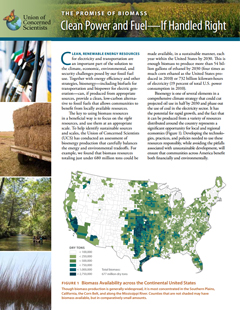Biomass — plant material and animal waste — can be used to create transportation fuels and generate electricity, but the key to using biomass resources in a beneficial way is to focus on the right resources and use them at an appropriate scale.
To date, food crops (corn, sugar, and vegetable oil) have been the primary source of biofuels for transportation, but increased use of these fuels has created more problems than solutions: rising food prices and food price volatility, and accelerated expansion of agriculture in the tropics.
This UCS analysis focuses on the four primary non-food sources of biomass — energy crops, agricultural residues, waste materials, and forest biomass — and details the amount of each type of biomass that could be sustainably produced and utilized in the United States without compromising the fertility of agricultural soils, displacing land needed to grow our food, or threatening the health of our farms and forests.




